| Figure 1 : Percentage of respondents interested in traveling to space |
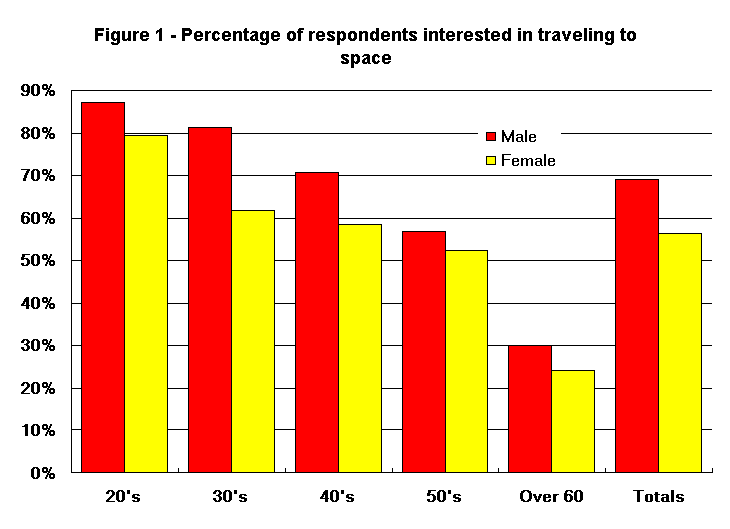 |
Demand for Space
Tourism in America and Japan
And its
Implications for Future Space Activities
Patrick Collins - Visiting Researcher at NAL and Tokyo University,
RCAST
Masataka Maita - National Aerospace Laboratory (NAL)
Richard Stockmans - York University, Schulich School of
Business, Toronto, Canada
In 1995 market research on the potential demand for space tourism was carried out in the USA and Canada, supported by the National Aerospace Laboratory of Japan. Although estimates have been published before, this is the first actual market research of its type to be done on the North American market. This paper describes the research, and compares the data with earlier research conducted in Japan. Although there are a number of differences in the results, they are broadly comparable to those in Japan, which suggests that space tourism services would also be very popular in North America. The paper then considers the implications of this research for future space activities and space transportation systems.
In considering the feasibility of space tourism, assessing the potential market is very important in providing information on the potential scale of the demand at different service prices. North America is the largest single consumer market in the world, and consequently data on the potential demand for space tourism services in the USA and Canada is of great interest.
In 1993, the first market research on demand for space tourism was carried out in Japan, supported by the National Aerospace Laboratory (NAL). That survey of 3030 Japanese people across all age groups revealed a surprisingly strong popular wish to visit space : more than 70% of those under 60 years old, and more than 80% of those under 40 years old, stated that they would like to visit space at least once in their lifetime. Furthermore, some 70% of these said that they were prepared to pay up to three months' salary for such a trip (1).
Despite the fact that the authors of the Japanese survey urged other countries to do similar research, no US survey was performed in the following two years. Consequently, NAL took steps to have a comparable survey carried out in the USA and Canada during August and September 1995. Although estimates have been published before, this is the first actual market research of its type to be conducted in America. The results illustrate that interest in traveling to space is also very high with North Americans. Overall, 60% of the people surveyed were interested in traveling to space for a vacation.
These results have significant implications for the future of space activities, in that the resulting estimates of the potential size of the civilian space travel market far exceed estimates for any other commercial space market. As a consequence, many of the current vehicle designs for future space transportation systems may need significant design adjustments.
The market research was carried out by means of a telephone poll of 1020 households selected quasi-randomly across the USA and Canada. For purposes of comparison between this study and the study conducted in Japan in 1993, the telephone questionnaire was modeled as closely on the written questionnaire used in Japan as possible, considering translation and cultural differences. It was expected that consumers' opinions would be influenced somewhat by the different surveying procedure, and this point is considered further in the discussion on the international comparison of data below.
Like the earlier surveys, there are a number of uncertainties that must be kept in mind concerning the interpretation of the results of this study. These points and others are discussed at some length in an earlier paper (1).
The sample taken was designed to represent all those individuals in both the US and Canada who have access to a telephone and are between the ages of 20 and 80. At the time the sample was taken, this represented a potential market of approximately 170 million people, based on almost universal telephone ownership in North America. The sample of 1020 respondents was divided up among the geographic regions of the two countries based on the population distribution of the states and provinces. The respondents were sampled by randomly selecting telephone numbers from the white page phone listings of each region. A constant digit was then added to the selected phone number. By using this method, all individuals with access to a telephone, including those not listed in the telephone book, became a part of the sample.
In total, almost 5500 calls were placed to complete the survey. Eighty percent of the numbers dialed were registered phone numbers, and 45% of those were answered by a person. The response rate for being interviewed was high in terms of standard telephone marketing research, with 52% of the calls connected to a potential respondent completed. It is important to note here that the respondents were not informed of the subject of the interview until after they agreed to participate in the survey. In this way, no bias was made towards interviewing only those who were interested in completing surveys relating to space travel or the like. See Appendix A for details of the exact language used in the interview.
Sampling and Non-sampling Error
Due to various constraints, the authors believe a small amount of sampling error exists in the survey data. First of all, error was introduced in the sample by interviewing the first person who answered the telephone on each call. Although in many cases, the person who answered chose to pass the call on to another, in the majority of cases the initial respondent completed the survey. An example of the error that can be introduced by doing this is, in western households women are statistically more likely to answer the phone than their male counterparts. Therefore by interviewing the initial respondent, the sample would contain a higher percentage of female respondents. In order to produce a sample that better represents the population, one needs to select a respondent randomly from all the individuals who reside in each household. This can be accomplished, for example, by asking to interview the person in the house with the next birthday. This procedure or others like it, however, considerably complicate the survey procedure and increase the time needed to take the sample.
A comparison of the sample taken in this study with national statistics is shown in Table 1. The table shows the overall distribution of the survey participants by age and gender, and compares them to the US population as a whole. (Adding the figure in the variant column to the corresponding age group yields the percentage of that group in the overall US population, census data - 1990. The Canadian population distribution is quite similar.)
Table 1 : Breakdown of respondents with comparison to the US population
Gender |
Male |
Female |
Total |
Male Var |
Fml Var |
Total Var |
20's |
11.4% |
13.8% |
25.2% |
0.6% |
-2.1% |
-1.5% |
30's |
10.5% |
12.5% |
23.0% |
1.7% |
-0.2% |
1.5% |
40's |
7.4% |
11.6% |
18.9% |
1.7% |
-2.2% |
-0.4% |
50's |
5.7% |
8.2% |
13.9% |
0.5% |
-1.6% |
-1.1% |
Over 60 |
7.2% |
11.8% |
18.9% |
1.8% |
-0.3% |
1.5% |
Totals |
42.1% |
57.9% |
100.0% |
The distribution by age matches the overall population very closely ; none of the five age groups considered is over- or under-represented by more than 2.2%, confirming the representativeness of the sample in this respect. The distribution by gender however, as discussed above is significantly different, with women over-represented and men under-represented by 6.3 %. In the following wherever necessary, the figures are adjusted to compensate for this. Overall, this analysis shows very little difference in composition between the population and the sample, and therefore this type of sampling error is considered small.
The largest source of sampling error in a telephone survey usually can be attributed to non-response. This arises because many people are not at home when called (54% of the numbers dialed), and many individuals (48% of those contacted) choose not to participate in the survey. This survey was administered during selected periods of time during the week : Monday - Friday from 5 pm to 9 pm, and on Saturday from 11 am to 7 pm. These set time-frames were chosen to reduce non-response due to refusals, and to increase the likelihood that more people in each household would be at home to answer the phone. It is recognized however, that calling during specific time periods can exclude certain portions of the population who may be doing shift-work, or certain age-groups who may not typically be at home during these time-periods. Calling on Saturdays and also the Labour Day holiday may have helped to reduce this error. Possible ways to determine if biasing is present, includes making call-backs to numbers where there was no answer, and interviewing individuals who refuse to do the survey on their first option by coaxing them with some type of reward. These measures however, were considered unnecessary in this case because of the nature of the survey. All in all, it is unlikely that significant error has been introduced in the data with the sampling method used.
Non-sampling error for this study is considered to be very small since the interviewing sessions were conducted in a highly controlled manner. The use of computer programs to dictate the survey text so that each participant received exactly the same information, as well as to collect, process, and analyze the data, decreased the possibility of error being introduced in these processes to a minimum.
The survey consisted of 17 questions and took approximately four minutes to complete (refer to Appendix A). Respondents who were not interested in traveling to space, had a much shorter survey to answer that took only half the time. The first section of the survey collected basic personal information on the respondent, as well as information concerning interests and traveling preferences. The second half of the survey began with the following space tourism concept statement : "Consider for the moment that it is possible to travel to space as a potential vacation alternative. Imagine that people are able to go there using a means of transportation similar to a plane." The respondent was then asked "Would you be interested in traveling to space - yes or no". If the respondent answered no, they were queried as to why. If they responded yes, the survey continued with more specific questions concerning a space trip.
Several open-ended questions in the survey stimulated many interesting opinions and comments from the respondents, which suggests that many people have given considerable thought towards the idea of traveling to space for themselves. In the future, a more detailed analysis of the results of this survey will be published, and those comments will be given further attention. For the present, the following paragraphs briefly describe the study's main findings.
Figure 1 shows the basic level of interest in traveling to space, broken down by age and gender. As an overall average, more than 60% of the population say they are interested, with a higher proportion of younger people being interested, as one might expect. The overall average figure is comprised of more than 75% of those under 40 years old; 60% of those between 40 and 60; and more than 25% of those between 60 and 80. It is notable that in every age group men were more interested than women, the average difference being about 10%. This is rather different from the results of the survey in Japan, where no significant difference was found. This may be due to the fact that many US astronauts are military staff, whereas all the Japanese who have visited space are civilians.
| Figure 1 : Percentage of respondents interested in traveling to space |
 |
Figure 2 shows the length of time participants would prefer a space trip to be, broken down by age groups. A substantial majority of all age-groups say that they would prefer to go to space for either several days, one week or more. In all age-groups, no more than about 15% of the people say they would prefer a visit of a few hours or one day ; the majority have a clear preference for a longer stay, some 30% of those under 50 preferring "several weeks". The questionnaire did not discuss the relative price of different lengths of visit. In reality, a longer stay will be more expensive, but these results give no information on participants' price-sensitivity. It seems reasonable to conclude that, in the absence of orbital accommodation enabling people to stay for a few days, the demand for space tourism will not reach its full potential.
| Figure 2 : The length of time respondents would prefer a space trip to be |
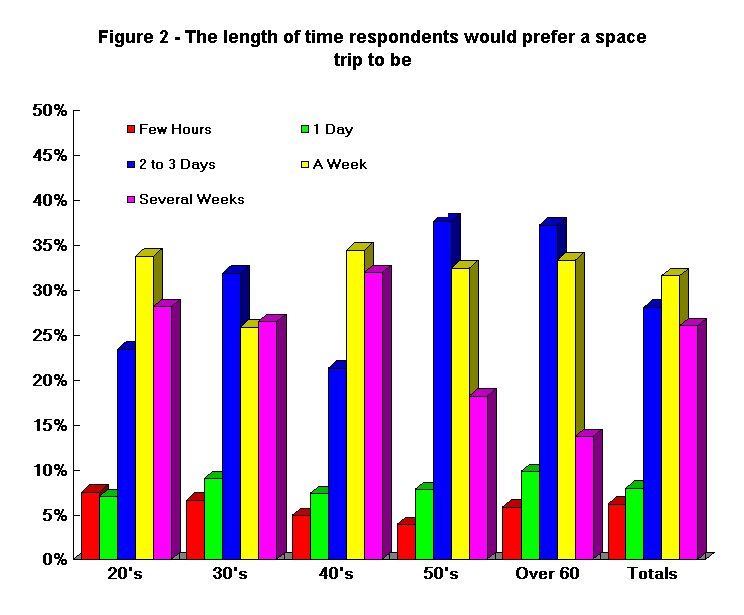 |
Figure 3 displays the amount that respondents interested in traveling to space would be prepared to pay for a trip, expressed in months of salary. The first point to note is that there is little difference between the various age groups on this variable. At the upper end of the range, it is interesting that 2.7% of those wishing to visit space (representing almost 3 million people) say that they would pay three years' salary. Clearly for these people traveling to space is a very strong desire. 10.6% (representing 11 million people) say they would pay a year's salary, which is still a very substantial expense. 18.2% of participants (representing 19 million people) said they would pay six months' salary, and 45.6% (representing 48 million people) say they would pay three months' salary.
| Figure 3 : How much people feel is the proper proportion of their income for a space trip |
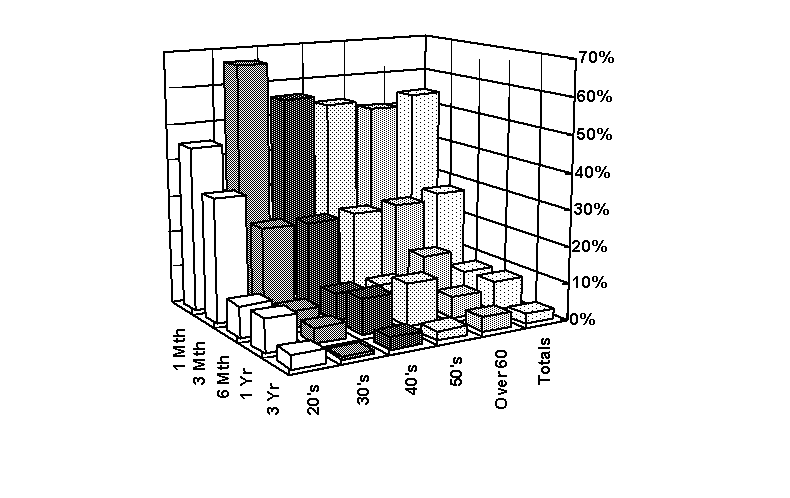 |
In further analysis of the data, average income statistics for different age-groups will be used to derive a demand curve and study market segmentation for the North American market. For the present we simply note that the overall average income for North Americans is approximately $2,000 per month, or $12,000 for six months' salary, and $24,000 for a year. In addition, two thirds of those wishing to visit space said that they would like to do so several times, not once only. Consequently, even allowing for a substantial gap between consumers' intentions and their actions, space travel could clearly be a multi-billion dollar per year market in America alone. Ten percent of the above estimate is still more than $60 billion in funds that people say they are willing to spend on a space trip.
Figure 4 shows a breakdown of the reasons given by those who did not wish to visit space. Roughly 1/3 of each age group said that they are simply not interested in the idea. It seems likely that these people would not go, even if the service was available. However, some 5 - 10% said that they consider the idea unrealistic, and presumably some of these would wish to go once the service was really available. Roughly 1/3 were concerned primarily about safety, which emphasizes the over-riding need for reliable space transportation. Some of these would presumably reconsider once the service was something like that of today's airline travel. A substantial fraction of these respondents however, said that they were afraid of flying, and so it must be assumed that they would remain unwilling under any circumstances. Finally, most of the people who considered themselves too old to go, were still interested in traveling to space if it had been available when they were young. Overall, it seems that the average of 60% interested in visiting space could grow to 70% or more in the event that a regular service became available.
| Figure 4 : Reasons people are not interested in traveling to space |
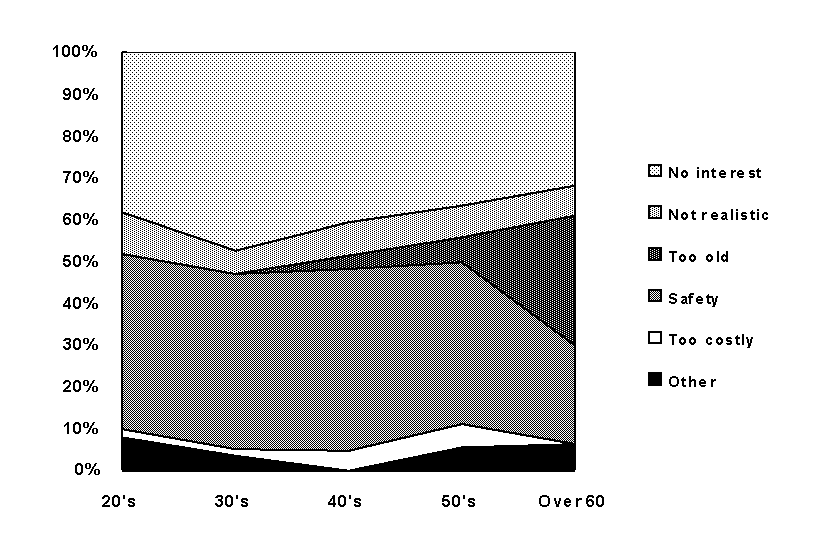 |
A weakness in terms of complete consistency between all respondents is suspected by the authors in terms of personal interpretation of the space tourism concept statement. Since the respondent was free to envision what the space trip and vacation would entail, it was felt that in some cases the respondent thought they might be traveling to far away places or planets on the trip. Whenever questions arose as to where one might be traveling on a space trip, it was suggested by the interviewers that these trips would be mainly in orbit around the earth. Although some misinterpretation may be present, it is felt that most respondents had a clear picture as to what would be involved ; a vacation orbiting the earth or slightly beyond. Discussions with the interviewers during and after the study attempted to elicit information concerning this issue. If bias is present due to the lack of clarity involved, it could move the results in either direction, but probably not by a substantial amount.
One of the more interesting aspects of this study is that it enables a comparison of data to be made between different national markets. It appears from these results and others that the desire to travel to space is consistent with popular idea that people of all cultures are intrigued by, and eager to experience traveling to space for themselves. Here we briefly compare the results of the two similar studies carried out in Japan and Germany.
A survey using a similar format was recently carried out on 200 people using the two airports in Berlin, of which the results will be published in detail in the near future (2). The data are particularly interesting in being the first such market data to be collected in Europe. Because airport users are a well-characterized economic group, the results allow us to draw conclusions about the middle and upper income group of the German population, and also reasonably firm conclusions about western Europeans as a whole (2). In combination with the American and Japanese data, Figure 5 shows the comparison of the amounts that people said they would pay in these four countries. More detailed analysis is required to draw precise comparisons, but the similarity between the North American and German data is striking. The figures for Japan are noticeably higher.
| Figure 5 : Comparison of the prices people are willing to pay for a trip to space in various international markets |
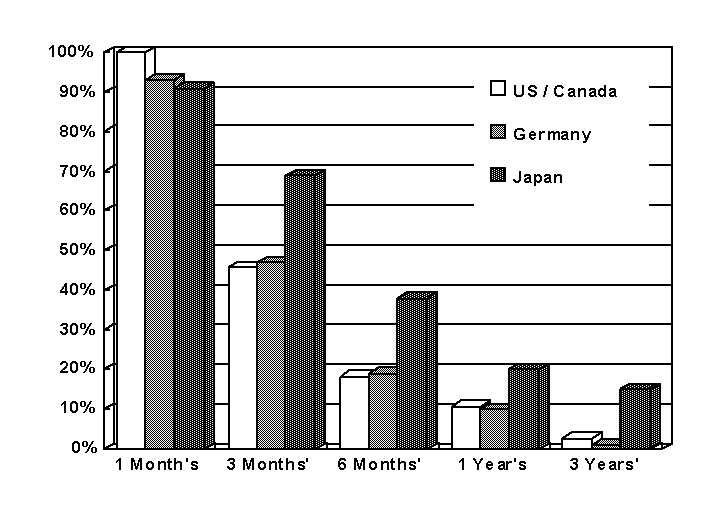 |
In comparing the American results with the earlier data on the Japanese market, we must make allowance for differences in the circumstances of the two surveys that might lead to differences in the results. A significant difference between the two survey procedures was that in the telephone survey participants were given minimal information about what form the service would take. It was clear from some of the comments made by respondents that they were envisaging something rather similar to a flight on an existing launch vehicle, and at the other extreme, dreaming of a trip on the futuristic starship. In the Japanese however, participants were given an illustrated pamphlet explaining that the service would be rather like air travel today, and passengers could stay in an orbital hotel. It is to be expected that this would increase the attractiveness of the prospective service. Another difference is that Japanese personal savings are much than Americans', and consequently Japanese people may more easily envisage a rather large expense for a particularly desired activity. Other potentially significant differences are the two year difference in the dates of the surveys, the difference between a written and a verbal survey, and recent media events in the countries concerned. Thus, at the present early stage of this market research, it would seem premature to claim that even such an apparently major difference as that in Figure 5 is real, either as representing a significant difference between the countries concerned, or in terms of the data being in error.
More striking than this possible difference is surely the fact that people from such different countries, approached in such different ways, answer the basic question of whether they wish to visit space with such a high similarity. A large majority of young people, a majority of the middle-aged, and a substantial minority of people in their 60s and 70s say that they wish to visit space, and many are prepared to pay several months' salary to do so. We can surely conclude that personally traveling to space is an almost universally popular ambition.
From surveys of the world's two largest consumer markets, and supported by data from Europe, we provisionally conclude that if the price of a return ticket to low Earth orbit could be reduced to between $10,000 and $20,000 per person, a substantial fraction of the populations of the rich countries, of the order of 100 million people, would wish to make such a trip. In this case the scale of the resulting business would seem to be limited primarily by how fast the capacity could grow, but the world-wide demand for short visits to low Earth orbit over time could apparently reach the scale of one million passengers per year or more, generating annual revenues of $10 billion or more.
Based on this demand, what can we say about the economic feasibility of developing a transportation system for space tourism? A market of the order of 1 million passengers per year paying of the order of $10,000 per person would generate revenues of the order of $10 billion per year. Thus the market potential of space tourism is somewhat similar to that of the new generation SST vehicles. In both cases of course, there is a very delicate balance between the scale of the actual market and the affordable cost of development, production and operation. In addition, the uncertainty concerning the actual level of demand in different countries, and the potential for revenue increase through market segmentation is still high, and needs to be investigated more thoroughly.
In order to reach the low launch costs needed to create a space tourism business, the economies of scale possible from accessing the entire global market will also be very important. Thus, from a business point of view, a collaborative, international civil project has the best possibility of success through supplying the global market (3). Success will also depend on achieving safe and comfortable flight conditions, comparable to air travel today. Such low launch costs, are of course a challenging objective, and the subject of "space tourism" is still controversial. For example, in 1994 NASA's Office of Advanced Concepts and Technology described space tourism as "only a flight of fantasy" (4). However, since then NASA has agreed to participate in a joint study of space tourism with the Space Transportation Association (5).
To date, very little research has been done on passenger vehicles suitable for commercial service. Consequently, more work needs to be done to study how reusable launch vehicle systems can reach the necessary operating cost targets. Estimates of the development cost of reusable passenger launch vehicles are also uncertain, ranging from billions of $US to tens of billions of $US. Yet even the highest of these figures are less than the cost of the international space station project alone, while the demand for tourism apparently has the potential to grow to many times the most optimistic projections for existing commercial space activities.
By rough order of magnitude analysis the space tourism market appears to be attractive, however considering R&D and production costs for a new launch vehicle, these market estimates become marginal.
A low cost, safe and comfortable launch vehicle is key.
Value can be added to the service via space hotels or other space infrastructure.
International collaborative research is the best way to go about developing and solving these issues.
Today government space agencies face declining budgets, with a clear prospect of further cuts, fundamentally due to lack of popular support in the new post-cold war era, for the work that these agencies do. In this situation, trying to do what the public say they want, even if it seems difficult, is surely a good direction to take. In public opinion polls only about 20% of Americans describe themselves as "very interested in space". But this recent market research shows that the large majority of people, 60% "want to visit space for themselves", and would be prepared to pay high prices for such a service. It therefore seems probable that many of the public would prefer public money to be spent trying to reach this target even if it is difficult, than on projects such as advanced satellite technology or a space station for government researchers.
A scenario of space tourism development provides an interesting alternative vision of future space activities, one in which passenger space travel might become the major space activity. Business competition between travel companies, similar to that between airlines in the early days of aviation, would progressively increase demand and reduce costs. The fleets of passenger launch vehicles and the orbital accommodation needed to satisfy the demand of hundreds of thousands of passengers per year would represent major new markets for manufacturing and operating companies, and would be the first commercial demand for crewed space activities. This would be a major, and popular change of image from today's current space activities.
Appendix A : Space tourism questionnaire and supporting text
Introduction
Hello, my name is Doug Mackenzie and I'm a college student calling from Toronto, Canada. I'm conducting a research study all over North America and I was wondering if you could spare a couple minutes to answer a few questions for my study.
[Wait for response - If agreed to do questionnaire, continue with the following explanation about the topic of the questionnaire]
Explanation
What we are trying to do with this research is determine what people's attitudes are towards the concept of space travel. In the study we are trying to determine what kinds of people are most likely going to want to travel to space and who may not, so I will need to ask you some questions about yourself and then I am going to ask you your opinion, okay..
Basic Personal Information
Could I have your age?
1. Age
[Enter gender - the interviewer doesn't ask for this information unless it is necessary]
2. Gender
and your marital status?
[Interviewer waits for an answer and categorizes it, or suggests alternatives]
3. Marital Status
4. What is your level of education? Did you go to high school .... college?
Do you currently work? ... and what do you do for a living?
[Interviewer categorized the answer]
5. What do you do for a living (occupation)?
Are you interested in ... ?
6. What are your interests? - Yes or No
When you take a holiday, do you vacation within your state, in North America or do you travel internationally?
7. Do you vacation?
Have you gone anywhere you consider exotic?
Space Trip Concept Description
Consider for the moment that it is possible travel to space as a potential vacation alternative. Imagine that people are able to go to space using a means of transportation similar to a plane.
8. Would you be interested in traveling to space - yes or no?
If no - Why are you not interested?
[open-ended answer, that was completely recorded]
[If yes - the survey continues with questions specific to a space trip]
9. How long would you like the trip to be?
10. How frequently would you travel on such a trip?
11. With whom would you like to go to space?
12. What do you feel is the proper proportion of your income for a trip to space?
13. What is your motivation for taking a space trip?
These last questions are all yes or no answers.
14. Would you be interested in doing any of the following activities while in space?
If information were available about the following space topics would you like to read about
15. What information about space would you like to have?
Is there anything else you would like to have information about?[open-ended]
16. Which of the following are concerns you would have, regarding a trip to space?
And the last question is ..
17. Have you seen the movie Apollo 13?
Well that completes the survey, thank you so much for taking the time to share your opinion. Take care .. Bye bye.
Acknowledgements
The authors would like to give special thanks to all those who were involved with the interviewing procedure and the project in general - Jacquie Koppens, Karen Hill, Michel Quintas, Sara Graham, Jeremy Stockmans and Suzanne Stockmans.